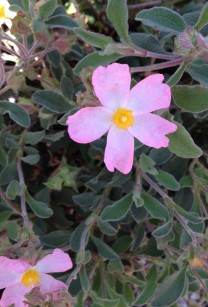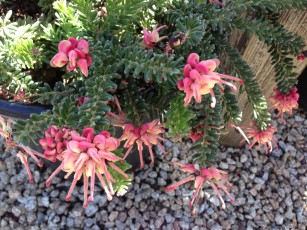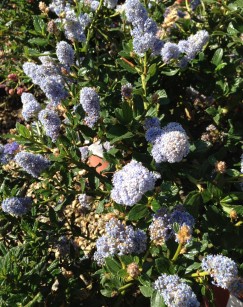 There are so many great plants that don’t require a lot of water to look beautiful. It’s always a plus if they attract hummingbirds and other wildlife. Some favorites are so reliable that we consider them tried and true. Who doesn’t want to include more plants like this in the garden? On the lookout for cultivars of old favorites I came across a few that I plan to include this year in my own garden and also in upcoming drought tolerant designs. I’m excited.
There are so many great plants that don’t require a lot of water to look beautiful. It’s always a plus if they attract hummingbirds and other wildlife. Some favorites are so reliable that we consider them tried and true. Who doesn’t want to include more plants like this in the garden? On the lookout for cultivars of old favorites I came across a few that I plan to include this year in my own garden and also in upcoming drought tolerant designs. I’m excited.
Rockrose is a medium sized shrub that works in so many low water use situations. Besides nice looking foliage the flowers of this shrub provide lots of color, too. With soft grey-green leaves and lovely baby pink flowers, Grayswood Pink cistus is a winner. It grows to about 3 feet tall and 4-5 feet across and is covered in blooms from spring to summer and then sporadically through the year. Bees, butterflies and birds are all attracted to rockrose. Leave it to the British to be at the forefront of gardening trends, the Royal Horticultural society gave this cultivar their Award of Garden Merit in 2002.
Rockrose are tough evergreen shrubs but they do not respond to hard pruning. Best  to lightly trim each year to control size as needed. They are tolerant of poor soils and are quite drought tolerant once established. Hardy to 15- 20 degrees they survive our winter lows. Other rockrose favorites of mine include the variety Sunset which grows to only 2 feet high and 4 feet wide with bright pink flowers much of the summer. I also like cistus purpureus for its glowing magenta flowers with a red spot at the base of each petal. Its? common name is Orchid rockrose which is Pantone’s color of the year.? Rockroses are deer resistant.
to lightly trim each year to control size as needed. They are tolerant of poor soils and are quite drought tolerant once established. Hardy to 15- 20 degrees they survive our winter lows. Other rockrose favorites of mine include the variety Sunset which grows to only 2 feet high and 4 feet wide with bright pink flowers much of the summer. I also like cistus purpureus for its glowing magenta flowers with a red spot at the base of each petal. Its? common name is Orchid rockrose which is Pantone’s color of the year.? Rockroses are deer resistant.
Grevilleas are one of those plant families that have so many types of flowers, growth habits and sizes that they hardly seem to be related to each other at all. Most are native to Australia and so flower during our winter and early spring. They are invaluable nectar sources for hummingbirds and other nectar feeding birds when most of our plants are still snoozing. If you have deer problems plant Rosemary grevillea. Scarlet Sprite is a mounding, compact shrub 4 feet tall by 8 feet wide with soft textured needle-like leaves. The rosy pink and cream colored flowers are showy in winter and spring. It’s hardy to 20 degrees and is similar to Noelii which was once the most common grevillea in cultivation in California but it’s not as prickly and is denser growing also.

If you want a drought tolerant low spreading groundcover to attract hummingbirds plant a Wooly grevillea.? I especially like the pinkish-red and cream spider like flowers of the variety Mt Tamboritha. They grow about 1-2 feet high and spread to 4 feet in sun or partial shade. They are tolerant of moist soil and are hardy to about 18 degrees. The nectar-rich flowers are abundant in winter and spring but they will bloom sporadically during the rest of the year.
We are lucky there are so many ceanothus varieties native to California. From  groundcovers to large shrubs there’s a plant size to fit every location in the garden. Ceanothus thyrsiflorus is one of the shrubs starting to bloom in our area right now. Ceanothus thyrsiflorus grow along a narrow band close to the coast from Monterey to southern Oregon. Growing to 8 feet Bixby Bridge has large sky blue flowers that attract bees and hummingbirds. With large shiny green leaves and those huge flowers it will steal the show in your garden.
groundcovers to large shrubs there’s a plant size to fit every location in the garden. Ceanothus thyrsiflorus is one of the shrubs starting to bloom in our area right now. Ceanothus thyrsiflorus grow along a narrow band close to the coast from Monterey to southern Oregon. Growing to 8 feet Bixby Bridge has large sky blue flowers that attract bees and hummingbirds. With large shiny green leaves and those huge flowers it will steal the show in your garden.
There are a few other drought tolerant plants that I have my eye on. They include a new variety of rosemary called Mozart. It has the darkest blue flowers I have ever seen and will grow into a mound 3 feet tall by 6 feet wide. Hardy to 10 degrees it will fit in nicely in dry gardens mixed with lavenders and rockrose.
The new lavender variety I found is called Lavender Silver Frost. Named for its incredible powder-white foliage and dark purple flowers its gorgeous.? At just over 2 feet tall and a 3 feet wide it’ll be beautiful with the rest of dry garden plants.
